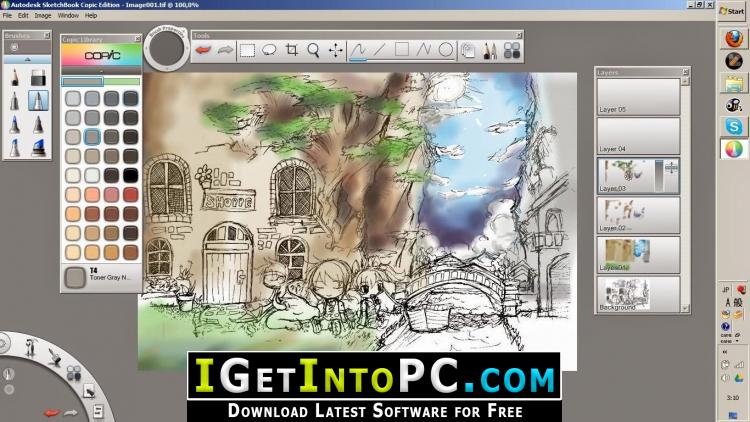

Most of the sketchbook images are in graphite. This is a categorised list of sketchbook images. This is the itinerary of the expedition and this is the story of his sketchbooks from the Beagle expedition which are in the Cambridge University Library.
Conrad Martens (English 1801–1878) accompanied Darwin on the Beagle as expedition artist and produced three detailed sketchbooks of places visited and objects seen on the expedition. This is an example of a Sketchbook at the Victoria and Albert Museum Some of his sketches were in oil while others were in small sketchbooks. John Constable (English 1776–1837) believed in the importance of working from life and based his paintings on sketches and drawings of the landscape. Turner sketchbooks, Turner Bequest, Tate Britain This link provides access to all 300 sketchbooks. Five years after his death, the majority of his art was bequeathed to the nation and is housed at Tate Britain JMW Turner (English 1775-1851) produced 300 sketchbooks and around 30,000 sketches and watercolours on his travels. sketchbook drawings held by Museum of Fine Art in Boston. Eight albums of sketchbooks by Goya This link provides a summary of each of the albums, what it contains and what materials were used - the site is still under construction.  The Italian Sketchbook created in the 1770s and currently in the Museo del Prado. Goya (Spanish 1746- 1828) was a painter and print maker and made an important contribution to the art of drawing. Getty Museum – sketch of an artist in his studio. Rembrandt van Rijn (Dutch 1606-1669) Good example of Rembrandt's sketches and drawings can be found in:. Leonardo da Vinci (Italian 1452-1519) made hundreds of pages of sketchbooks during his life, filled with drawings and writings that went along with his very curious mind, you can find some of his sketchbook pages at the following link:. Links are provided in the external links section below. A number of the sketchbooks of famous artists have been digitally recorded and are now available online. The World Wide Web has increased access to documents such as the sketchbooks of famous artists which previously would only be seen in an exhibition. In displays of contemporary art, as well as historical retrospectives, intimate and ephemeral records are increasingly valued, resulting in the exhibition of sketchbooks alongside "finished" artworks.Ĭomputer technology has allowed for the development of digital sketchbooks, such as Apple's iPad devices and Microsoft's Surface tablets. Sketchbook paper comes in a variety of tones, ranging from pure white, to cream, and includes less common varieties, such as gray. Certain paper characteristics might be more desirable for use with certain mediums.
The Italian Sketchbook created in the 1770s and currently in the Museo del Prado. Goya (Spanish 1746- 1828) was a painter and print maker and made an important contribution to the art of drawing. Getty Museum – sketch of an artist in his studio. Rembrandt van Rijn (Dutch 1606-1669) Good example of Rembrandt's sketches and drawings can be found in:. Leonardo da Vinci (Italian 1452-1519) made hundreds of pages of sketchbooks during his life, filled with drawings and writings that went along with his very curious mind, you can find some of his sketchbook pages at the following link:. Links are provided in the external links section below. A number of the sketchbooks of famous artists have been digitally recorded and are now available online. The World Wide Web has increased access to documents such as the sketchbooks of famous artists which previously would only be seen in an exhibition. In displays of contemporary art, as well as historical retrospectives, intimate and ephemeral records are increasingly valued, resulting in the exhibition of sketchbooks alongside "finished" artworks.Ĭomputer technology has allowed for the development of digital sketchbooks, such as Apple's iPad devices and Microsoft's Surface tablets. Sketchbook paper comes in a variety of tones, ranging from pure white, to cream, and includes less common varieties, such as gray. Certain paper characteristics might be more desirable for use with certain mediums. 
Sketchbooks made out of high quality paper, differentiated by weight (referring to density of the sheets) and tooth (also called grain), allow for a wide variety of techniques to be used, ranging from pencil drawings, to watercolor, to colored pencil, to pen and ink, and so on. Sketches are sometimes removed from sketchbooks at a later date. Many artists personalize their sketchbook by decorating the covers. Over time, it might allow others to see the artist's progress, as their style and skills develop.

Finish of the work found in the sketchbook varies widely depending on the artist and their style of work, with some having very simple drawings and notes, and some having highly worked images. Sketchbooks began as a way to provide a readily available supply of drawing paper in the convenient form of a book. Sketchbooks come in a wide variety of shapes and sizes, with varied covers, and differing numbers of pages.








 0 kommentar(er)
0 kommentar(er)
